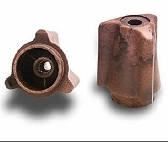
A thermoplastic material made exclusively from renewable resources is based on lignin, a natural polymer which is formed by photosynthesis and makes up about 30 % of the substance of every tree and every wood plant. Lignin is second to cellulose as the most abundant natural polymer and, in the tree trunk for instance, forms a three-dimensional supporting structure around the cellulose fibres. Lignin gives natural, as-grown wood the necessary compressive strength, which cellulose cannot provide. The cellulose fibre can only provide tensile strength, which means a compound of natural fibres (cellulose) and lignin makes a material that, just like natural wood, can withstand tensile and compressive loads in combination. By varying the composition of ARBOFORM® both in terms of quality and quantity it is possible to adjust strength, rigidity, dimensional stability with varying temperatures, and other material properties so as to suit specific product requirements.
Lignin is a byproduct of the papermaking industry and about 50 million tonnes are produced in various pulping processes worldwide every year. So far the uses for lignin have been limited, about 95 % being incinerated for thermal energy generation. It is just a small percentage of the lignin that has found material applications, e.g. in the foodstuffs industry.
By mixing specific types of lignin with natural fibres from wood, flax, hemp, sisal or other fibrous plants and natural additives a composition is produced which can be processed at raised temperatures. This material is made into mouldings, sections or panels on conventional plastics processing machines in just the same way as a petrochemical thermoplastic material.
It can be used in a variety of applications from furniture, consumer electronic housing, automotive interior, consumer products. The thermoplastic properties make that it can be used in injection moulding processes.

Comments by our Users
Be the first to write a comment for this item.